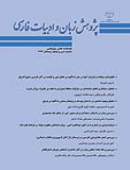تقابلهای دوگانه و کارکرد آنها در متن با تأکید بر تقابل نور و ظلمت در آثار فارسی شیخ اشراق
محورهای موضوعی : پژوهشهای ادبیات کلاسیک ایران
1 - استادیار گروه زبان و ادبیات فارسی دانشگاه گنبد کاووس
کلید واژه: تقابلهای دوگانه نور و ظلمت متن باختین شیخ اشراق,
چکیده مقاله :
تقابلهای دوگانه، اصطلاح کلیدی در نظام زبانشناسی سوسور، ساخت گرایی، شالوده شکنی و مکتب باختین است که در فهم معنا و نظام تفکر انسان، نقش بنیادینی ایفا میکند. همگی این مکتبها در پذیرش تقابلها به عنوان عامل اساسی شکل دهنده در نظامهای گوناگون زندگی بشری رویکرد مشابهی دارند؛ لیکن در تفسیر نحوۀ تعامل دو جانب یک تقابل، دیدگاههای متفاوتی دارند. صرف نظر از پیامدهای چگونگی تفسیر تقابلهای دوگانه در زمینههای گوناگون فلسفی، اجتماعی، فرهنگی، تاریخی و...، آنچه مهم مینماید، تفاوت در نگرش و خوانش متن ادبی است که هر یک از آن مکتبها و نظریهها بر اساس تفسیر خود از تقابلها، به دست میدهند. این نوشتار میکوشد مفهوم و چگونگی تفسیر تقابلها در ساختگرایی، شالوده شکنی و مکتب باختین را بکاود؛ آنگاه برای نشان دادن چگونگی عملکرد و تفسیر تقابلها، تقابل نور و ظلمت در آثار سهروردی، شیخ اشراق، بررسی شده است. نتایج بررسی نشان میدهد که نگرش آفرینندۀ متن ادبی و خوانش متن بر اساس آرای این نظریهها به تقابلهای دوگانه، به بازتولید متنهای متفاوت میانجامد که بر اساس رویکرد تک آوایانه یا چندمنظری نویسنده، متن اثر وجوه متفاوتی به خود میگیرد. همچنان که در مصنفات شیخ، تقابلها به مانند فرجامی که ساختارگرایی به تقابلها میدهد، کیفیت برتریجویانه یا وحدتبخش دارند(1).
Bilateral contrasts is a key term in Ferdinand de Saussure linguistics, constructuralism, deconstructuralism and Bakhtin school which plays a pivotal role in understanding the meaning and human thinking system. All these schools have a same approach in accepting contrasts as a pivotal forming factor in different human life systems; however, they have different interpretations in the kind of encountering of both sides of a contrast. Regardless of the consequences of interpreting bilateral contrasts in different philosophical, social, cultural and historical fields, what is important is the difference in attitude and reading of literary text every one of which result in a different interpretation. This article analyzes the concept of interpreting contrasts in constructuralism, deconstructuralism and Bakhtin school; then proves the contrast of interpretations by concentrating on contrast of light and darkness in Suhrawardi's works; The results show that the attitude of creator of the literary text and text reading, based on these theories, result in bilateral contrasts and result in reproducing different texts which get different voices based on mono-vocal or multi-attitudinal approach of author. It is the same as Sheikh e Ishraq works, contrasts as the end that constructuralism gives to contrasts, they have besting or unifying quality.


